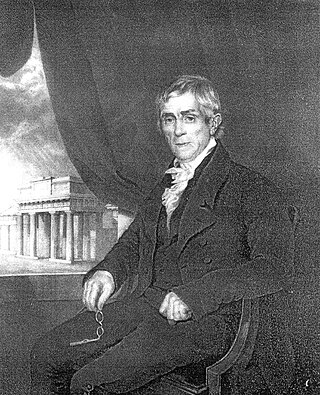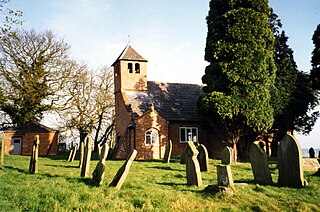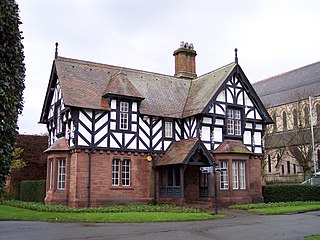
Chester Castle is in the city of Chester, Cheshire, England. It is sited at the southwest extremity of the area bounded by the city walls. The castle stands on an eminence overlooking the River Dee. In the castle complex are the remaining parts of the medieval castle together with the neoclassical buildings designed by Thomas Harrison which were built between 1788 and 1813. Parts of the neoclassical buildings are used today by the Crown Court and as a military museum. The museum and the medieval remains are a tourist attraction.

Beeston Castle is a former Royal castle in Beeston, Cheshire, England, perched on a rocky sandstone crag 350 feet (107 m) above the Cheshire Plain. It was built in the 1220s by Ranulf de Blondeville, 6th Earl of Chester (1170–1232), on his return from the Crusades. In 1237, Henry III took over the ownership of Beeston, and it was kept in good repair until the 16th century, when it was considered to be of no further military use, although it was pressed into service again in 1643, during the English Civil War. The castle was slighted in 1646, in accordance with Cromwell's destruction order, to prevent its further use as a bastion. During the 18th century, parts of the site were used as a quarry.

Thomas Harrison was an English architect and bridge engineer who trained in Rome, where he studied classical architecture. Returning to England, he won the competition in 1782 for the design of Skerton Bridge in Lancaster. After moving to Lancaster he worked on local buildings, received commissions for further bridges, and designed country houses in Scotland. In 1786 Harrison was asked to design new buildings within the grounds of Lancaster and Chester castles, projects that occupied him, together with other works, until 1815. On both sites he created accommodation for prisoners, law courts, and a shire hall, while working on various other public buildings, gentlemen's clubs, churches, houses, and monuments elsewhere. His final major commission was for the design of Grosvenor Bridge in Chester.

The Old Dee Bridge in Chester, Cheshire, England, is the oldest bridge in the city. It crosses the River Dee carrying the road that leads from the bottom of Lower Bridge Street and the Bridgegate to Handbridge. A bridge on this site was first built in the Roman era, and the present bridge is largely the result of a major rebuilding in 1387. It is recorded in the National Heritage List for England as a designated Grade I listed building, and is a scheduled monument.

Chidlow is a civil parish in the Cheshire West and Chester district and ceremonial county of Cheshire in England. In 2001 it had a population of 8.

Tushingham is a scattered community in the civil parish of Tushingham-cum-Grindley, Macefen and Bradley, in the Cheshire West and Chester district, in the county of Cheshire, England.

St John the Baptist's Church is in the village of Aldford, Cheshire, England. The church is recorded in the National Heritage List for England as a designated Grade II listed building. It is an active Anglican parish church in the diocese of Chester, the archdeaconry of Chester and the deanery of Malpas. Its benefice is combined with those of St Peter, Waverton and St Mary, Bruera. It is described by the authors of the Buildings of England series as "expensive" and "stiffly conventional".
The Grade I listed buildings in Cheshire, excluding those in the city of Chester, total around 80. Almost half of these are churches that are contained in a separate list.

Grosvenor Park is a public park in the city of Chester, Cheshire, England. It consists of 20 acres (8.1 ha) of land overlooking the River Dee. It is regarded as one of the finest and most complete examples of Victorian parks in the North West of England, if not nationally. On 22 August 2013 the designation of the park was raised from Grade II in the National Register of Historic Parks and Gardens to Grade II*.

Kaleyard Gate is a postern gate in Chester city walls, Cheshire, England. It is recorded in the National Heritage List for England as a designated Grade I listed building.
The timeline of Cheshire history shows significant events in the history of the English county of Cheshire.

The Recorder's Steps consist of two flights of stone steps leading down from the outside of the city walls in Chester, Cheshire, England. They lead from the walkway at the top of the walls to a riverside area known as the Groves, and are recorded in the National Heritage List for England as a designated Grade I listed building.
The Chapel at the Countess of Chester Hospital is located in Upton-by-Chester, Cheshire, England. The chapel is recorded in the National Heritage List for England as a designated Grade II listed building.

The English Presbyterian Church of Wales is in City Road, Chester, Cheshire, England. The church was built in 1864, and designed by Michael Gummow of Wrexham. It is constructed with a stuccoed front and brick sides, and has a slate roof. The architectural style is Neoclassical, Its entrance front is in five bays; it has a portico with four Ionic columns, and a three-bay pediment. The opposite end of the church is apsidal. The church is recorded in the National Heritage List for England as a designated Grade listed building.

The Welsh Presbyterian Church is in St John Street, Chester, Cheshire, England. The church was built in 1866, and designed by W. & G. Audsley of Liverpool. It is constructed with a yellow sandstone front, brick sides and rear, and a slate roof. The plan consists of a simple rectangle, with an apse at the east end, and a narrower single-storey narthex at the west (entrance) end. The narthex is supported by octagonal piers at the corners and two granite columns between them. On each side of the narthex is a lancet window. Above the narthex is a large rose window, with a lancet window above, and a cross finial on the gable. The church is recorded in the National Heritage List for England as a designated Grade II listed building. The wall and the iron railings and gates in front of the church are included in the listing.

The Town Crier is a public house located on the corner of City Road and Station Road, Chester, Cheshire, England. It stands opposite Chester General Station. It is recorded in the National Heritage List for England as a designated Grade II listed building.
There are over 9,000 Grade I listed buildings in England. This page is a list of these buildings in the unitary authority of Cheshire West and Chester.

The Statue of Richard Grosvenor, Second Marquess of Westminster is in Grosvenor Park, Chester, Cheshire. England. It was designed by Thomas Thornycroft and was erected to commemorate the generosity of the Marquess. The statue was unveiled in 1869, and was paid for by public subscription. It is recorded in the National Heritage List for England as a designated Grade II listed building.

The equestrian statue of Viscount Combermere stands on an island in Grosvenor Road, Chester, Cheshire, England, opposite the entrance to Chester Castle. It commemorates his successful military career, and was made by Carlo Marochetti. It is recorded in the National Heritage List for England as a designated Grade II* listed building.

The Statue of Queen Victoria stands in front of Chester Crown Court in the forecourt of Chester Castle, Chester, Cheshire, England. It was unveiled in 1903, the sculptor was Frederick William Pomeroy, and the statue is recorded in the National Heritage List for England as a designated Grade II listed building.

















